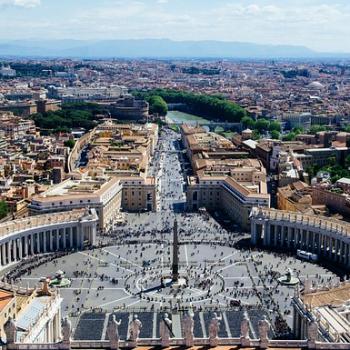In Sermon 3 of the Sermons on the Song of Songs, Bernard uses a metaphor of "three kisses" to describe the journey of ever-increasing intimacy with God. When we first turn away from worldly concerns, we are like Mary Magdalene, kissing Christ's feet. As we grow in grace, we are like a grateful servant, kissing the hand of the Lord—a metaphor for our attempts to live a graceful, holy life. But finally, the one who truly enjoys mystical union is like the lover who kisses the beloved on the mouth. In Sermon 74, Bernard offers a detailed description of a mystical encounter with Christ. It's an encounter filled with mystery, one that the saint struggles to put into words: "He did not enter by the eyes, for he has no color; nor by the ears, for he made no sound; nor by the nostrils, for he is not mingled with the air, but the mind. He did not blend into the air; he created it. His coming was not tasted by the mouth, for he was not eaten nor drunk; nor could he be touched, for he is impalpable."2 Bernard goes on to note that "only by the warmth of my heart . . . did I know he was there"3—a statement that we find echoed in John Wesley's famous encounter with Christ, where his heart felt "strangely warmed."4
Steeped as he is in the language and the worldview of the Middle Ages, Bernard's writings may not be immediately accessible to us here in the third millennium. But the sensuality and honest love that shaped Bernard's faith and spirituality shine through, especially in his sermons. Many later mystics, such as Julian of Norwich, Teresa of Ávila, and Thérèse of Lisieux, stand on the shoulders of this medieval troubadour of God's infinite love.
Recommended Reading
Bernard of Clairvaux: Selected Works, translated by G. R. Evans (New York: Paulist Press, 1987).
Blaise Pascal (1623–1662)
Blaise Pascal, best known as a French philosopher, scientist, and mathematician, was also an amateur theologian and a mystic who had at least one passionate, fiery encounter with the love of God for two hours on a Monday night. When he died shortly after his thirty-ninth birthday, he left unfinished a work called Pensées (Thoughts), which apparently was intended to be a defense of the Christian religion. Beautifully written, it reveals the author's keen understanding of the paradoxes and mysteries of faith, suggesting that spirituality ultimately must be grounded in humility.
The loving heart of Pascal's mystical faith was recorded on a single sheet of paper called his "Memorial," which he carried with him in the lining of his coat. Dated Monday, November 23, 1654, the memorial records in poetic, ecstatic, almost incoherent language an encounter with "Fire. God of Abraham, God of Isaac, God of Jacob. Not of philosophers and scholars. Certainty, joy, certainty, emotion, sight, joy . . . Oblivious to the world and to everything except God. He can only be found in the ways taught in the Gospel . . . Joy, Joy, Joy and tears of joy."5
What exactly happened to Pascal that evening, for two hours starting about ten thirty? As cryptic as the "Memorial" is, we can only speculate; but it reads like nothing so much as a love poem, apparently signifying such a meaningful encounter that its author kept it near his heart for the remainder of his short life.
Recommended Reading
Pensées and Other Writings by Blaise Pascal, translated by Honor Levi (Oxford: Oxford University Press, 1995).
Catherine of Siena (1347–1380)
Catherine of Siena is one of the most remarkable women of her age. In addition to being a renowned mystic and a popular saint, she was active in church politics, helping to bring the papacy back to Rome from Avignon, France, where popes had resided for almost seventy years, and then attempting to resolve a schism that occurred two years before her death (which would not be resolved until 1417). Rejecting her mother's plans for her to marry, Catherine became a Third Order Dominican, which meant she continued to live in her family home but observed a life of prayer and silence. A visionary since childhood, at age twenty-one Catherine underwent her "mystical marriage" to Jesus, consecrating her life and her virginity to him. She wrote a mystical treatise called The Dialogue a few years before her early death at age thirty-three.
One of her most renowned visions consists of a bridge from earth to heaven, symbolizing Christ. This bridge represented the love of God, through Christ, flowing to the earth. As Catherine writes in The Dialogue, reporting the words that God had spoken to her,
I said that, having been raised up, [Christ] would draw everything to himself . . . the human heart is drawn by love, as I said, and with all its powers: memory, understanding, and will. If these three powers are harmoniously united in my name, everything else you do, in fact or in intention, will be drawn to union with me in peace through the movement of love, because all will be lifted up in the pursuit of crucified love.6
Recommended Reading
Catherine of Siena: The Dialogue, translated by Suzanne Noffke (New York: Paulist Press, 1980).




